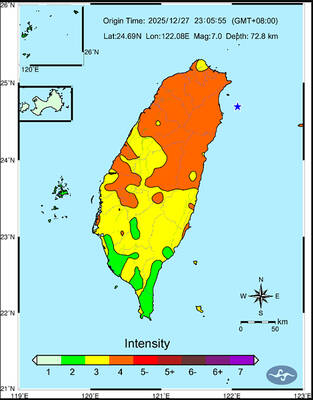China said yesterday it has begun issuing warnings to foreign military planes entering its self-declared air defense zone over the East China Sea amid heightened tensions with its neighbors, especially Japan.
Chinese state media quoted air force spokesman Shen Jinke (沈金科) as saying several kinds of Chinese planes recently patrolled the sweeping zone that was declared in November.
He said the planes identified several foreign military aircraft, flew alongside them and issued warnings. He did not identify the planes or say when the patrol was conducted.
The zone is a “purely defensive measure that conforms to international practice,” Shen said.
The US, Japan and other countries denounced the zone’s declaration in November as provocative and said they would ignore China’s demands that their military aircraft announce flight plans, identify themselves and follow Chinese instructions. China has said it would take unspecified measures against aircraft that disobey.
In a policy address yesterday in Tokyo, Japanese Prime Minister Shinzo Abe reiterated Japan’s position, saying it would “not tolerate any attempt to change the status quo by force.”
He said Japan would beef up its defensive capabilities “in order to defend the safety in the southwestern region, as well as the vast sea and airspace around Japan.”
Meanwhile, Japanese Cabinet Secretary Yoshide Suga told reporters that he was aware of reports that China had issued warnings to foreign aircraft, but declined to confirm them.
“I don’t understand what China means by voice-warning,” Suga said.
Japan’s defense ministry has not reported any “abnormal flights” by Chinese military jets since Beijing declared its air zone, he said.
The zone is seen primarily as targeting Japanese and US military flights over the East China Sea. Its declaration followed more than a year of heightened tensions between China and Japan over control of a series of tiny uninhabited islands in the East China Sea. The zone pointedly incorporates the islands — known as the Senkakus in Japanese and the Diaoyutais (釣魚台) in Chinese — which are also claimed by Taiwan.
The zone also incorporates a vast area of international airspace from Taiwan to the Korean Peninsula and overlaps in places with zones enforced by South Korea and Japan.

A magnitude 7.0 earthquake struck off Yilan at 11:05pm yesterday, the Central Weather Administration (CWA) said. The epicenter was located at sea, about 32.3km east of Yilan County Hall, at a depth of 72.8km, CWA data showed There were no immediate reports of damage. The intensity of the quake, which gauges the actual effect of a seismic event, measured 4 in Yilan County area on Taiwan’s seven-tier intensity scale, the data showed. It measured 4 in other parts of eastern, northern and central Taiwan as well as Tainan, and 3 in Kaohsiung and Pingtung County, and 2 in Lienchiang and Penghu counties and 1

FOREIGN INTERFERENCE: Beijing would likely intensify public opinion warfare in next year’s local elections to prevent Lai from getting re-elected, the ‘Yomiuri Shimbun’ said Internal documents from a Chinese artificial intelligence (AI) company indicated that China has been using the technology to intervene in foreign elections, including propaganda targeting Taiwan’s local elections next year and presidential elections in 2028, a Japanese newspaper reported yesterday. The Institute of National Security of Vanderbilt University obtained nearly 400 pages of documents from GoLaxy, a company with ties to the Chinese government, and found evidence that it had apparently deployed sophisticated, AI-driven propaganda campaigns in Hong Kong and Taiwan to shape public opinion, the Yomiuri Shimbun reported. GoLaxy provides insights, situation analysis and public opinion-shaping technology by conducting network surveillance

‘POLITICAL GAME’: DPP lawmakers said the motion would not meet the legislative threshold needed, and accused the KMT and the TPP of trivializing the Constitution The Legislative Yuan yesterday approved a motion to initiate impeachment proceedings against President William Lai (賴清德), saying he had undermined Taiwan’s constitutional order and democracy. The motion was approved 61-50 by lawmakers from the main opposition Chinese Nationalist Party (KMT) and the smaller Taiwan People’s Party (TPP), who together hold a legislative majority. Under the motion, a roll call vote for impeachment would be held on May 19 next year, after various hearings are held and Lai is given the chance to defend himself. The move came after Lai on Monday last week did not promulgate an amendment passed by the legislature that

AFTERMATH: The Taipei City Government said it received 39 minor incident reports including gas leaks, water leaks and outages, and a damaged traffic signal A magnitude 7.0 earthquake struck off Taiwan’s northeastern coast late on Saturday, producing only two major aftershocks as of yesterday noon, the Central Weather Administration (CWA) said. The limited aftershocks contrast with last year’s major earthquake in Hualien County, as Saturday’s earthquake occurred at a greater depth in a subduction zone. Saturday’s earthquake struck at 11:05pm, with its hypocenter about 32.3km east of Yilan County Hall, at a depth of 72.8km. Shaking was felt in 17 administrative regions north of Tainan and in eastern Taiwan, reaching intensity level 4 on Taiwan’s seven-tier seismic scale, the CWA said. In Hualien, the